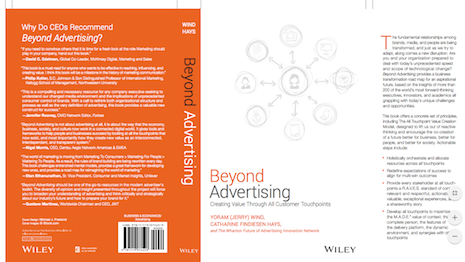By Yoram (Jerry) Wind and Catharine Findiesen Hays
Excerpted and adapted with permission from “Beyond Advertising: Creating Value Through All Customer Touchpoints,” by Yoram (Jerry) Wind, Catharine Findiesen Hays and the Wharton Future of Advertising Innovation Network. New Jersey: John Wiley & Sons, 2016. Copyright © 2016 by Yoram Wind and Catharine Findiesen Hays. All rights reserved. Adapted for style
In life, we know that timing is everything. Suggest something to someone or to a group of people at the wrong time or in the wrong place and the consequences are not only bad at the moment, but likely bad for the foreseeable future. We’ve wasted their time and we’ve wasted our own time, even if what we had to say might have been perfectly valid. We may never get a second chance if we are woefully off. Conversely, looking for, being ready for, and/or creating just the right setting and surroundings, when the person is in the right frame of mind and emotional state, increases the likelihood of positive outcomes for all. Done consistently, thoughtfully, over time, in subsequent circumstances and situations, the positive connection, appreciation, and trust can be lasting. Such is the power of context.
 “Beyond Advertising: Creating Value Through All Customer Touchpoints,” by Yoram (Jerry) Wind, Catharine Findiesen Hays and the Wharton Future of Advertising Innovation Network
“Beyond Advertising: Creating Value Through All Customer Touchpoints,” by Yoram (Jerry) Wind, Catharine Findiesen Hays and the Wharton Future of Advertising Innovation Network
By 2020, brands will be held to the same standards as people, and they will have the wherewithal and self-interested, aligned motivation to deliver. Advances in science and technology give us an unprecedented ability to listen for and understand the psychological, social, and cultural nature of humans, and the ever-evolving technologies to predict, perceive, and deliver on these nuances. Publishers, producers, gamers, media properties, platform providers, retailers, technologists, architects, product, service, software and app developers, and their collaborators are continuously creating an exploding array of tools and techniques to leverage the richness of context across all touchpoints.
So what do we mean by context? In order to change our mindsets for the future, we chose this term as the least anchored in the past to enable us to think as broadly, holistically, and dynamically as possible, to take full advantage of the many ways that we can enhance the value of what we have to say (content/substance) with when, where, and how we say or do it. Context in the future will be as powerful as content. And rather than arguing about which one is king or queen, we believe that the savvy will take full advantage of what each can offer in value creation for the triple bottom line.
 Yoram (Jerry) Wind is Lauder Professor, professor of marketing at the Wharton School, and academic director of the Wharton Future of Advertising Program
Yoram (Jerry) Wind is Lauder Professor, professor of marketing at the Wharton School, and academic director of the Wharton Future of Advertising Program
On behalf of our Advertising 2020 collaborators, we’ve distilled six contextual design dimensions that expand the consideration of context for the future. Not all are relevant for every touchpoint. But given how powerful they can be, we advocate thinking creatively about each one and revisiting them frequently to see what else can be mined. We suggest that the context be “M.A.D.E. to the power of S”, where synergy with other touchpoints can have exponential impact:
• Multisensory aesthetic: Beyond the ever-important look and feel, how can all five senses be considered and celebrated? How can they be used to enhance the contextual power and value?
• Audience frame of mind: What is the recent, current, and future emotional state, frame of mind, mood, role of the audience in the current context? Who are they with, what are they doing, and why?
• Delivery mechanism, interface and platform/medium: What are the characteristics and properties of the particular interface, including physical place, human face, hardware, and software?
• Environment and location: Where are they, what’s taking place in the physical environment, and what’s the tone and manner in the surrounding environment? What’s the relevant vibe?
• Synergy: How can one context become exponentially more valuable for all by leveraging synergies with and among other touchpoints?
Multisensory aesthetic
Once the domain of only physical spaces, the power of the five senses will be appreciated and optimized across all touchpoints. We can learn from the best of retailers who understand and fully leverage the power of look, smell, sound, touch, and taste to provide the right context-creating. We all know the examples of context-wrecking. That insufferable music on hold. The musty smell in the store. But done right, the music, the scent, the look and feel, the right flavor, and we are transformed into a new world. Imagine each touchpoint being designed with all senses in mind.
We gained a lot of understanding on the power of visual context from our research on native advertising. Our colleagues at Yahoo! Asia Pacific early on saw the potential of this emerging new alignment between publisher/platform, brand, and audience. Native advertising is the notion that instead of something intrusive relative to the primary content on a site or media property, advertisements would look and feel more like the rest of what audiences were seeking and experiencing. A favorite analogy is Vogue magazine, where readers value the first third of the magazine’s pages—where brands’ advertise fashions, photography, and prose—at least equally to the editorial content. What we found is the power of contextualization. Content from brands that meet the same standards of the look and feel of the editorial content is more highly valued by audiences. We appreciate advertising that is additive to our experience, rather than competing for our attention.
Audience and individual’s frame of mind
Research confirms the contextual importance of emotional, psychographic, and sociographic elements: how someone is feeling, what their frame of mind is and where they are in this moment relative to others. Several Advertising 2020 collaborators cited the work of Daniel Kahneman, who illuminates the power of the emotional part of the brain. Kahneman’s book, Thinking, Fast and Slow, is structured around the metaphor of System One and System Two. Kahneman describes System One as follows: intuitive, automatic, effortless, and unconscious; it simplifies and shapes available information into narrative coherence; it is associative, impressionistic, emotional, nonstatistical, gullible, and heuristic. System Two, by contrast, is what we traditionally consider our “thinking” self: it is conscious, deliberate, effortful, slow, statistical, and suspicious. It takes System One’s rough draft of reality and polishes it up with reasoned arguments and clear findings.
But System Two, in addition to being the more logical and rational of the pair, is also lazy. It costs a lot of resources (i.e. time and energy) to use. Because of this, instead of slowing things down and rationalizing them, System Two is often content to accept the convenient but inconsistent reality that System One provides it. Kahneman makes it clear that while System Two at times offers directional insight, System One—with all its heuristic shortcomings—is really the one at the helm (Kahneman 2013).
The ability to understand the nuanced aspects of these factors will have a huge impact on advertising. Technologies are emerging to discern someone’s frame of mind by the cues and clues they give in real time, so that we can address them accordingly. Other companies are experimenting with using voice recognition to evaluate our state of mind. Social platforms (acknowledging that this term is likely to be obsolete by 2020) have a tremendous amount of information about your choices and are able to describe you in ways far more addressable than a generic message. We are just beginning to understand the potential of enlisting analytics to create relevant clusters for whom brands can personalize messages.
Audience frame of mind takes into account not only the state of the individual, but how they might be influenced by who else is in their physical and virtual world at that moment. I would talk to you differently if you were alone, in a study group, at a concert, sitting next to your child, at home engaged online, in a virtual game with your team from around the world, or viewing a demo of a product or service for work. In each setting, you are a different mode: solo, student, concert-goer, parent, game competitor, business person. Wonderfully and understandably your frame of mind is altered by whom you are with.
Delivery mechanism, interface and platform
Context also encompasses the means through which we connect. If we go back to our analogy at the beginning, we know there is a big difference if we connect in person versus if we call or text or email or post or SnapChat. Or send a handwritten letter.
• The device or delivery mechanism: Is it a mobile phone? A digital billboard? A newspaper? A container? A customer service agent? The product itself? An app? A social media site? The brand’s website? An event or a happening?
• The interface: Is it broadcast? Interactive? Touch screen? Motion-sensitive? Voice activated? Voice recognition? Ambient? A game console? Human? Augmented Reality?
• The platform/app: Is it social? News? Entertainment? Productivity? Hobby? Neighborhood?
Each layer has increasingly robust capabilities as well as differing relationships with the audience. Mobile isn’t necessarily on-the-go, as 68 percent of all smartphone minutes take place in the home (AOL, BBDO, & InsightsNow 2012). Additional research emerges daily about the differences in how we relate to our variety of mobile devices, and this will continue to evolve. The key is to have an open mind to the art of the possible.
Environment and location
Today, advertisers are increasingly using unexpected touchpoints within our environment to create powerful campaigns. There are a large number of examples, but here is one of our favorites. The level of pollution in China is a major public health concern, and factories produce 65 percent of the airborne toxins. Xiao Zhu, an air purifier company, was seeking to enter the market. Working with Y&R Shanghai, the company developed the campaign “Breathe Again,” where pictures of choking children were projected onto the smoke billowing from smoke stacks. While certainly aiming to gain traction in a saturated market, Xiao Zhu used the lived environment to reveal a normally innocuous presence, and increased public awareness about air pollution by 38 percent (Cannes Lions Archive 2015).
And this is just the level of environmental engagement companies are capable of today. By 2020, communications with audiences will have a far greater ability to be locally contextualized. This will be primarily driven by the extent to which sensors will pervade our world. Just think “smart and connected everything.”
But of course we don’t have to wait for the full deployment of these connected technologies. And we may very well see a trend toward sensor-blocking if these potentially beneficial connections are abused. The fact that a significant percentage of the world’s population are rarely without geo-locational devices—smartphones—gives the carrier and app world tremendous contextual data on our environment. And this is just the beginning of locational ways of understanding and relating to a person’s context.
Synergy
As we think about the design principles for each touchpoint, perhaps the most important is to build into the design of each the capacity and functionality to work seamlessly in concert with the others. Not only is the whole greater than the sum of its parts, the interaction among the parts makes the whole exponentially greater than single executions.
CONTINUING WITH OUR analogy from the outset of the chapter, the better we know someone, the better we can use all the means at our disposal to create the best environment to get our message across. And yet, we also know that we are most vulnerable to those who know us best. Hence, the flip side of being able to know so much that we can contextualize our message and connections and actions as brands is that it can enable what we do not want: intrusive, manipulative, underhanded, duplicitous, deceptive, insidious, heinous, illegal, destructive advertising. For this reason, aligning objectives and outcomes with individuals and society is essential. We hope for a future where advertisers have the wisdom to know when not to be present. This restraint may well be the most important value creation of all.
Yoram (Jerry) Wind is Lauder Professor, professor of marketing at the Wharton School, and academic director of the Wharton Future of Advertising Program, Philadelphia. Reach him at [email protected].
Catharine Findiesen Hays is executive director of the Wharton Future of Advertising Program, Philadelphia. Reach her at [email protected].
Excerpted and adapted with permission from “Beyond Advertising: Creating Value Through All Customer Touchpoints,” by Yoram (Jerry) Wind, Catharine Findiesen Hays and the Wharton Future of Advertising Innovation Network. New Jersey: John Wiley & Sons, 2016. Copyright © 2016 by Yoram Wind and Catharine Findiesen Hays. All rights reserved. Adapted for style
{"ct":"3w51WfsP9lOUoCHLTQylPXGTk3bOt6NHM6NA9yxcc7Mugfra5yjFQcLVoNBfJDHTQZD8N9duGu3HO\/NmF1YmTVbwC8boe+aaJrp8wGxE3fY+J246Q6\/UUE55PZApsiIN+qS25cx+zie\/zEEnX8D0aWWVb5JHZIgnyuyjpZp3n5GUKSUHN\/cVrLoUC7YzJq7adY3g20BbK\/e9DxX258iGTAkv2daGlGMXu\/TNv0pBCtcXFJBsgA1xjLny9DJ5u+OEk0gRJmkS+Xc7DPfLgEWHs45mDvGXF8KrXJiBsd+IFOY5U\/C21bPIA+IhUUC4G+wm1Qq4d6Ru8pGWPzaTty9lFeZseTfrzuFYs+J72zO9LV6WKmP1Qa0RYeHdFN0x0ZiPRkuFaAkmFeHiRz6NFsdhyvZRdm7hpmn7HgUX8nowamHxj3hYtaxHdSoe+ll9LWzxrlffNQ14mQV9ymqBUNZj4IC2Ks0KG91GQ7U0DXhejeH09ulJ0ulv0W44+cmvEqeDVtakBJt58p83Vq4bZ6jrv1tCG8gd+414\/A2aUdmHFp25Df0VfxuBynO2dGTegskT9jos+1YEb4Jn3VuiJ2PcvZnzHzvAtQHrr3W3eyl0AWRXoS5NVYXlZcv6c5rtfYGYJoY7bor0uLmoTCsRinKQxyBE5ZhKNM6ktUQkGPH7pDCN07Pr5\/RQTNbn4NW7s9Iq3o+TQdQraE\/KtTxglcfoSpI1JQmUNPUSCNplgT2DPvdex0oggm7mTzJYa03oOAguLjWftgCL85BeJS4VD1Bz1ccz0\/jIh93R6FHNS7lzLqo+kuCyMBXbKq74lqjEcTu61M1dUEEfTzgxs4QTGKqN4FI1ov3FEojzTnXCsYgLS5TgmkPvmBqfg0PC\/8gfgP5pBevcQVJVITZqxhg1K9QLyzNGUsUzZcAIoGY0mbNww24zn3bU6zn+9kq+kceHeSkA6MYftqso5CCsT\/rVW5rocq5brnDxxpAnM3T7qrVMuXhCI7GDGB2ldzF2jHLNZ83YYxV7sevDC4EjEmCO\/g+TY1AKc6TezTaYSSBzFsF2EVnc2yg7SXJLk\/6l9X+NZbYGEhYflcAlaJ1I4QRNJYq9wrXCWxPNlOnynV14HYYmtRCDaHcwTIbdfgy+yEqWs4Zsg9ebE\/6OC3AydvO96f\/RD7Z8NqMbCModSFjdkvPGfQh83qUlKZRwf1rCrpdJk\/9Q4F2FZfdTNTaqIJgufhTXp33JjGDXGXsJYp3ZTEOpwuRDsQWsnsxkN0TnPdlkBPPlRcEZnHdEiuPBd5uSqad9Xp5C4IrPDcL+8UGXSyFy\/NCufRdNZwrlyx95RZSD1RhP\/EVkWLPch\/\/sz\/E5cN4m029QvCmyDAY7PP3SbT2bG4neuxM6sIdUjBvSvFV\/bHhS33o496PC6yNkzVwAKqrJFPmuHE2EhlW+EO0FMPQvO7IrtUt1wusJr40esqn561d+uR9fN3eER4lmLkFq\/dgsvrVPO\/4QVAfEbGUkMMoMCfLUkDqp8ptASpI\/U2MCssGfL3uElbetY+EbeAZR66eAu6ijfy++dmPsvm9zWxjOQ\/StHqH7w6kCYTiXhRZUrXS0b+n6j\/I4HyKW870EGbth3CvsGMCmQTbq+oP\/qRdFQTPBxeZ+pYejT8Fw6EBPJexr2LsT0PgYT94HPlzcaAB1RtbvTbrCuC9YRNw8pM1HDKlnf730fN5VEhHmaR3W8eD7k18NJJq7SVt6N4oSXTLOXj7my1udg17dETcqhSnPT7FuPZi1vr3IMxIUuL75pCdOuVNcnO0+LycIhASyQXW4Qukp6RPnpSKpDlKpRgmlMiry7nIupeaijOGTLcnZIJg9l\/r3z05EXaLjYVxAYPfc\/2aTPfwogBxn1paBXc6lQzuvwTI6BWpS6+e\/iMn8LmcSmUhEPmPOt\/QT9bBpO455bhTeZaCuLVp97VoLV7Gmp35SN1\/4R7vs4gbRL9PQzdfOCzLCziBnh0qyoWsvtaIn2dsuKBETImtADIVe3NBQCTLQvAbC0zRMyoWMRzFxj6k61\/oLsg44ekPA6pcxEEiyLFO\/e2NM35R1u3qFS0\/\/Of3FoLVv6Zp0J5DG2GFq7M9snLq6h25yUTeR6fJWMS0Mxnb61T9HrKx70SQh+m0mWwGtnAdMpxtuUSnzYtNS1f47n+Se5xcpc8mBozR679\/bUMAsccQbz6izoovrlnc+7U4iTzrwomqyEnvlsUF9GtEM4U0i4KhhZPQxaDGodCWFwwg3bLvTy+h2jU7MHJAupFUpsBHKr5xuRTBgWV1qRdWMhVc6Rvrdznnwvb5rwqdDz3yVRWFeZJrEFCFr37AMwlIka5y1FjkKjh3ZJk8DNuV1+N6kstKj1jxyj3Zj3XHBmH0kZ3tDs2+9rYtHho5B9inuf20fBpIztd8N87VcFEsq7uUb05hs21Gn\/CtU510KVFxOvz+rzQR1naVWe4mov6a7QJu8dmsuHJbEd20TR2EkRcXhWSBKZ6H8pZvg8PHfWsd6kfO6BGhnKkU1pFLvMdOMmiAvNtDjEalCmCKUllpib7nkzFdXOSOf\/ueRZnV9PuScANpylOGcFvEL+KeBHAhsgcTp\/azfVzbYSDHsQ+egl2wD2OVmDeIqDXL5ZMLPs2gmSto+lrkOY73Ao78dRtaboCoDb2615eZ+RxaDr8xDOf7KI1FjU6mcmSNjEzr9pEyOpzVuYzldhd5H+s589JDrQknYwbKekFerwd9kF4rwrISAgcTcAC8SLLjWmT+kHvYOopUDIk7LfWROBI6Pss16o1kN\/O3k+4Zc\/9XrlEPSLA2trPvM6WZUxwac58bbkrZYJTfjgVLu2vsx3i62yCUQSv97+mQzAW+xH9Rawyx2lsHEL3JyrO1aC+HNsmKd1jo+7UkuCFXK1Yr2uvRIMjSkYYF18X2NxWtUrEr2uafKMwV8a3y0dBcr1VE7A1KhwLfcNPxm0w\/M3LnOTz+mudQMVjPT9nlD7FZhsEmMqICMH3CbiRmJJi4RgeoNltfdiRxtIW0m9ow7sW\/D46aPw7Gyx+J1bc\/nZM898FjPPcjwnBzTjrMjSIewqMeNJ2yfliz+4PqViiEjjHaMxmi5vKYRERied9EMgx4wWE+zMHR9E9L9Fzl66r7GSPYLPUBVe949Adce8lOIBs77n4L26OqMKxH+wBhKO5S17Jc7z8zPEmzjkj8WuOWMoi2ONDz4iljEhBgJBAcDIWxOmtXojizLMpuPygPbVitepgKvXAMOngL5Uz+hRNahe7xjkiy\/ORcTuV0lMBG7YtkKZKrQK4JAcxlG1tVY9yt9gi+FjW3sQw6wmsamTP6iaZZEgE8hqOlZdiXhBMDL3Bx8300ymhrnvMxR8xCB+R9P1hb5up5YZT7JC4z2KeYC62+cy2uwOawXK5ayUxARhgF48aXwSnfPsPUc8j\/uxq1BlH6fanzMFPIoXEOmbw3JA6nPDJizvjizPz8n+hoD4fqrquupFUiEyhqVQE7\/C2DX6FEkKDk6jjsbK0gtbi1mRGas2fWmqL53af0r2\/MbRdU6J1xd9n7jInMi6eK+JDX73YWeg\/VgH5xdvPAoAewPrQS+CHO2ZB\/Fuk9NaGcqpSrdjqE4EI\/0TKU8gn+UdKbmL7tjvVcr3LTOa\/30tDM+\/wqRnmstsfqJbzDVdgAqdeqR25mfbNT9hkA3LRFyMoJroXn+iTNmK49WioSBZOt5rkcEmYBMhqcY1ze2fBdfw8PCliLF6B6ePXdyidE3sXotAwzta+7Bz3zfZlQ7uhLJXdufBWk4DCk2es4ttFc9eiU5xXkHHQ0Ya4qlXk1WnWlCYdyoV0RDCPpiTbUFrbRkDD\/c2\/Eav7qTi395La9V\/4kKDmq9AAakCu9xgzWvZHkZpWk7lCZmj7Z37k5yxeadt+RxSHIfFoLxgNqcIwmAKxZYI5lF4oCmGOZNbmA9POI7wLDezLXYUIcNlY5Kuew4MUptjNyofwrRvMD25QYBZKFVde8QNBUlbYjs5BAV\/jyM37j7IiJkb3rO27noenlBpoZP3O60iehYtPa8IIPbGkoEo6nUHoW1FK9JXJ2twhQ\/74BOXMikLQJ\/cwbwAhzm2DSZQuUM8B2ZzeDndklwFFeNV7i2IeCNsoMzL\/oHpDSsTXy5mj5A\/DsGsJ1iXllkxHqeWLu8L9\/0NL5SxyDn64bhPgxi5E5NitS3s2crPG+kyk5AQEZvJcX7eGJKdsmQYwzLS\/+v30+XFyfJ1ItVjD5+BgEjAwKBk9gOB8N1c71PA+KwEracslgp2TnDkNH5b3ASbpv52RnC3b0KgJZ3JdcPxuHLw\/yTh+ilFhYXCKRGg\/echpREYfwMfc5kUBlNMgVVvOUa8rIf0A1P7P6VVKmTjc24z4MwJF3aOKJo0zls5jQ5pj09riUpRMPByznzqmxXk7cjQKoag3EFdthxxWTvSouDHaYizqg+0tTqfNXUSCiGD4GALGHEj\/ZjWJxeQqyl35DC270yRYMvk7a+7HriqHPpGE+G1XjHnTgZCpZA3gBks8DK87b8wAcoLP2bWWWgOLwfJpb+8tDI\/wZfd27pHaENr0spIH56hBDF2n9T97kSY0BAEG5rtdHU6zWId3MnXA2XvC6ZDxNM6f+RhkiR\/by7Tegf\/FLG0O75DUOeiKKh9PChYtL5Y2H6PZdsqIBn+3I41N3pRVqHDMD1qC8VXmj6rMv8opXFEWdg1PyVdDW4J+cZzavt8Qq+5TI5qglDZZAHo4w4HWm1a27t+dM1TmOBrEOgHu52Q8PlftxVGs\/ggk1Rz0zV1RIKtTynEbz29xT4KFnBIiLIZqBR8BmAbKCrDT+tPCufQgPAFU5jCXK204F0mwVlTB6Txq\/QGZeo1\/Dp33rL7jwUcp2dlCh6L9GUe1OTZ2PwquONZpi\/DVwjz3LWWbXCAT55wXQWKFyyZYwLzwFAMWVgvl\/GtzK7j1EGkVr7MJ8LysV+0cPTZfyVlvwBgcDnTFdMEAWUZ6YEqBzt5ttstguBSpbqD83I\/arp\/D7TFAThc2JmuYXbLopcsdo7taSXdNo7lw+w9cGZRPj9X\/llArs\/qHst0QaftVZvtgbEkRHWomWv95xBOg0yAFlDNn3Xk\/cDbIXSkr3suwu2vqpJqvwRn0wOXzbd74h9ea8AkIkkznq9MxSLTGYPtC\/o6JGYe3fyzejZdIFFdJDwsTEVCLvi1PJistgvqnJmSS3KPLtj+avpuFdrMw+IbAuu6elcWta8xb72FlVVhSfTnv5mtOOQPudALGmrtYKCvs355j+QSTKQxQR\/pLWv75EznbpU1qhLU3DUe7tGQuXvpmLarwn2Pn6cpALbAhbzAJYb3VaH+0PnDWPrr64oT5G\/sUFkeRcAZF+0f2qwSbEI1IID4Qj9PfXuyAh1Shzz4WRnbBZwi+8uNnyIBjKgNS2rCTszr1n\/zsoICrK7CzZ9IPXyKcQyGtrSncWJOprONkREzSmqKi\/1pFbWA0dsAmZw1m\/ngJLHZtHykuhTh60qZ+iEkLGsBVSkcR67JhFEixPP3\/E5tXRg4aMCDF90JA\/OmXLJcf2iLo7A7E9QaB05uIfcjUc1j1hj2eRnlcMUtOceIa7ak8iNUPoTxM2oVT25f5k\/tbQSM5cmfLry9lxy27MoklIxKWGRNe6RXR4pwj8SebD9bb+TVf7sp5UqSNMyzEXGyLoZXMkOvhIEMsqIfDLyK+e5GaPhknVbcCQlScXaPP1rx6WiaF5rb+MyMT5NmpoWaMYNGrHZa4kVP7bGsallib00v4ziXi7TEt0k\/Q0mYMtadkDyVGqeiNdUzmP0z\/OtQzGm2NIQsYbqXpVxdCl792Rb75uZP15I4JGnUH04ygEgcuoxghhV4CM9kADuxWaL\/H55fdu0G3QotmAI05IihG0amt6ZSQVGq1At4a81\/GQ4w87IViJ7bR5j7E8Op1A1G4WO+ujXp2p5V1wvc4vg2vQQi3nLpdEAirH79xcdt85DUIPl9LpRYfGxuju7LxaSGS37uLpj9ZXfEXQ7W0K6kVBf1euNctrxjqSyBG9Fr2BAn1tVKRkoH6gLpfXm6x876sW+uKGuNZwyUaT1C2mmfF2LIg4tBPD06wWmtSgRVKiZewkbt2QJNpXojtbERKNmSQZPtMgL4RnqZ5x6Eb2ikncyCxWVwSsVrYruxJK9eRE3o8HtshkeyUqrSwa8eQBNz48qBipeS9lMAAfEBls38B\/OARPyqPiQ7kW+Q9R7mP7V+6+McIc+jrT4E4quttXmFd1BhGl341JeTHvPzwRTVTIKeklJYzyKuyAnZ\/vdLcN7xPtbaXkF3fa+AXUL4sMvYp2KfjcWyna0iuj7ZPiY\/MIWhNieHRyQhtjIJga4udhKzgv5h12v35F6sO8ttYORKiMVfJ\/LwZ9k29KVcLrkph0tFUbK+ETRaefFwasYu\/osr8dvirhGfIzjrrCBoe3i7lmUu3BNq4IPxuk+1+yMMaImfd8RF1qmhrxP0HbQHcbvupYYqn7\/8RpcrjVTWeBOhHMFRxZHX4UruE9EcdzxEwgBonuibErxnszoCaj9cQ\/VOYMM3JmB72UUMo+DgrUbp\/Zxa7nE\/djyUgDo3Swoy7x0WHADORntQlDOM7vAazNEoTmQ7AXoWZibyR9\/2MMBHipyiEaRItcxEhoT3sP2iTsPCR1\/S247naKx\/ad0W5oTm8LUFb688Nfkkrvr+sLVBCINq6ahkXwBuyL8EWNTUkg6yVKOJfCmNTPi7bpVvFg9dCYOOpfjzTAxAYq1eZtR8aPaED+OUOTSM7vw5CUdyGUOM\/M+Qkpy8+IqQGMDd1bnKqyxIIU2Q0lZfhqt4TEKYJMpfHUi7OGWcQY9LJtU0VQjCYrXseiMpybilmu8fRzx8GgjZ\/X3sZxs6xle+8caIPbh2Yq3Qv18\/vOCp8xz8MOf75\/4yhwYT0ljIpp3GJ1zitt12AJ8a7FL\/6kgIFgB\/Zxl60bHlhoPqW4SxImqYbv2a93bQzueD2bDzS8Hk2\/r1+maMWLPHHXSGEoPVRL1LHYwNKZBOaNmuqcJWhJkCKbj65IRkzZ+qOViqc659QIYqtOr4xDJksSsUjhjZW2EnyvfAeKNajiqHpD0THAqqtACXd1akhmlagVQcUDHGpLGApsc\/YBRjZMrDp6IjGkdI95O3C+y0uohyApdHWcDjYit9lvSCP0tECe6xQi4PvMePKI0ZLQGPyjCUN1Jnvxw45NSdclpld5g\/Skti+9aNL4R4ZBXj0U1hKHojeUBm6CYyY9mmAoHItzzunwAXeXp3k6rXA6KdQI10CgvwoB2+ZniVVvbdODPm74UrYWGkXC+Ds\/8kYVM39FZnY7AWSR9on9DpR+0IxF+p6Wm57jWkKvd8NDp2zQ55f85ejZxUba3kW1X17PpT2FimlL9YxI\/Nv8azOZB2L31OCe3CVOkEJzEPmIyAf5gtADpea0AAddE0MZCkpd316RgQPucIZRd7jPxyLv7TvlJWnpjuceqItsDDcVXTGQBRX2DCogGnqWwfDsd6zGi8UAb3vhn6TcGzyVkxUVIEbwOaOTyr1WyRlQdvCxACoBtB5iyIu8A9jYlldEqKm0yV3ukLbMbbLmVzi5iZJSPFNQ9nhLdQhgb8kw7rMtZHT42EYBQ0U6Nr+6lg2hH5fshcFEIXXhDvauZUECpZXgHtLQ1KffI5Ido0DWq+Cw4LbJtDQ4ByJetlWUug0FAjKtH\/3d+TlzX\/tCDBJv9vvhHBjtLOZC\/\/I8FbYqs6W3+idiOj2XAWRJTJmt3PR+4b2k2pyjhRQRBfhu48nF7EgPyEIRhSRfuSlvzzG9uZEMEt007NN8DQJgRv2JA2d3rWyNA5+WHD7QyUuINJ6ewLoYOEPLjDTKdfnoLQHQLxX5tK2QJ3zEofVVnIZzqby+MNzgtPpXjqJ3\/VmtUWFBFVoNcqahXB0X+kzsvncPVuwNS8ApW2SoCKo\/vSb2Rk0PEk1565fSAzxr8PuWTiQ2\/4QdRWtWAOBGpSE1bMFLSuDRgHgCnoN\/6FiODPyebTlDJevsJQdMVhepRnfVOWW1QrkF3TisTa\/SpsrIJI22P9YxXeAL18qasnEHjBg+DOAtH2A61xlSA4poW45Dxyvh6KenVFr+AOhLOtWyjOudXfUXr6qwdWl+qBeiwDCIZypWsFmsNzISgohpSjDZVfpPXNv0OjSJjG4QdDBXS2HckA4bQBuNKr3ltXAD9l3EEIBpyh5631IJT3iwYC1IpA86isA2YJmPnuliIPL9+eYErw1oipsi+f0uRkTtblzvbA6PCoTHvGF+jOMKrJBvrdh7I1yHomz0dPxImK0XMciuLoN\/7UcCbE1iWau640Iel9idUvAROzjkQzR06s1e4h7kCe0\/na8ph5WdJDLDfZ\/DmhKc35qzOyQt887X93xDDMzumt9U8fdgM8ExVCEt0LqSatKaXg1WiTLWukj6PAvZs1SyE8LRYDdaJkgSp2JWouQNyuj9Sa7AXoYtGEpy2\/g8Vv9hC1HB1Z9\/lkOhkpPbUCJCCE48UbywmStmD5BDsBMo79w3tfDHEUYgBstFDAvSsrvM6X2no4OIc6a+622rf0GKhF0XloKEdQqkpKVnxd3kieat8bRJERvNEO7aG9NAO465BxZmGp4Er5xzjBe\/8kVxe8PDH22apDHGP9fBEhM9cEYGhLhcs+dNLZD3bEsjo5LO+bWtTcSykyfhh01osorLmNPiZua6D7WXSlZL9ibLqm4U\/Guw9baKZjyuIBnGf8v1pVUoER23NEULUBshd3HK+FUbJuLbNBQx8YJed33HQdlsWJNFo5QrMAiM5lnI0QaN\/LTDCi3jv0Ow930BJ0ArY2kSgeLY60GcfULDP2OT80zsvTsDRki9rMxUOXP3opaNqrgbFsR5p5k2UIzI6cYqIcPIS+JmV0sigvJaQZaE5C5vih0qSxH7jskJh6gaU\/dsJsUef1hgqxBstKSGnmJPatnxmxUGQRz12Z31EDy7AaKbgNcmZDcZoXQTGFEV2kE0NRZMascgUsYnunDqEOim+9cWghooqDZk7u9XKVemGzYyTzayJwWsx\/+lw2b1CeHhBpmboONnfX8C+If0iiaJXD3sUa9X4\/3BT2j0bnGa1du2BMiI7cKoYpEM8sznWUi5C6LIirfigPfQPRMXnN9CeS6DKWXh\/LJTyTy8iE8OAEe\/btemECxQP5b6Mqss8VnMs8Y117yj2AyYN3uCqhUlO\/z1oTnGAUhTGb1g9Vpi4qyOhtXgg21ViH\/M2sPqQIeSHiyetWwjYYUhm2p9rVL79\/S7wW3X\/FRqhtjl7CEtxPb5uGVFIsjIw3Zx1lwDSihz1nROB8V6qiXBHEv4OhAV+qhHK443F5ZKdX6i9Ibt5rHWIcPQfytsjWnN\/orutzmDZXxhglWry\/abM1N6diiT7Bb6YTO2IJ+xhpl0kxm+Mrl0Rn6lAG9pVprmpSdxlBZW5CNH61S4tfcSlnuUY37vnwpAKUINw8ZlFz4F67cFWCunyVSGnwNv0ngfjA1Nh+1wC6IPUf\/l9QGaYZSlDtIA6AwoaSVzcNzwmzP4nr6SgQQdFldFFbuLR77PF\/zhMuwuRrpdggN\/SOPLeyKWVtdbBKFu+NG9cMXFhp9VaLFH4IkQhWrWmTTwtZgHTnS8KARfcQZXqiJ\/C653D+tdono71BGF4fNGYgkZNDCpVuBZezK9auV29uDsVeQx\/ag0NX3mSu27GoD1sDVv6fFjgFxLNFa04fP+QAVPeFNaIoe8jAyIKSOEoD22EpX41SWcelJVzELBwl3\/rn7hpYvduXJ3v6sNCdkdmBqLY31PYagklxEV+i8u9bntS3kXjYzMkRJrDWAVCmgVhaGesU0mUvm7jc2ZbaTl1pRerWYWUc9y+p6p393mty0GBHOon+UfGyadW87e5kaVQET6xnPwzcTaXrQmva2eby9TjTBPKJoLbOmqdqFancv5cv6seaDjWDE1e08tYOsvDlNYqQSjqT57MH1Zm+5JUSoDeiyIX0VTejq12utAN9oit81b2VPP9uDF6BIl3487PvK\/317aNWDdA4fDyCoeYiziSV44+KEr+\/n+nEnEwEWoMh4QJQu5ONQsbNSNIN8kEzz2RoBeu4f\/s7VhHTGFBbtfV1ADHaCbyEu4no5ZifN8ZPC1QX02qfE0ZWHCGLECryz71xIKbkCpDvrsV0JoSziKtzCDcmh1QVUGgeQ+4Tq9YPJn+vE6pbsrUF5lQ3FxEcVr+kMbBPsJ1\/tV48te9bLIMFYycQpuYhPI+yKbwKzSgj7DySfZE36ZINtD12UfOgL8tHo8yfNTO8jxalHqLAyxVE\/CkdUYWys9aSTD4\/cA01q7q4yikMpd7Du3kS9SjS8CfHYK6OhZPkRbvwqpEQfarXRdFzSJUTvI3aKzaPYS3bcGcUuHrniILocB5S8oxRLg7QiMKOfnj8eDEcbmKSN7TM8i6g+3hfpbcsH4J2eqXR4fi5aqtGR4uUK7mrOZfiIE6\/QUVn6HJerPSpvP\/MB1Dgeh+prb6yDjNNV0px5FIEBeU\/42S3pkE32NtL9rZnKD0h6bChnmyv8IGI0eTiQ6k\/fiZp8vNmI0mB\/9SBvZ\/\/suN+I4BolpQklUX88N0RQUe+VbK0xn9cPCTI4B6FtuBxWdzqunGWOQ9UmX15sbtq7CRHvu\/0jYwFO8I42A6wGBvOk6lWeAOVfo7XCmpXETjyWuRYi0Tb+vnVfk4reJd7fs9hL3Rj+dDvu+W4tk3uyQCfZQ4q6h92\/RG6QrBJsCStCAVRWcMqHdPH9\/09izByZNQ5dCZNAsKcTtlSk0Q6kk8NISnbs9gAklouF6AY7C5nSHpXCYPzKHyT43E4TAfoefGn4y1zP6vk+FMKlbSBC3qwMxpLSWlupEKvlY2su\/Ien0wIJ6xNbvITaj78iAAf8+2XtJBbML1Cu\/+hj1+VB6IZ+yvpNZQezd1ndIjuQBnT\/ylniPtSx6UBKhjx22lU36Lc2vbT3xDwaTKPofQkKgXLaRpIDoJkXOnbFQ2OxBytKmJNPQJc2h06ju2YHcgQk2GC57oodd868OL\/BBQV2OS5WRSrVN1AubnA9c8SoFwbmrplh5DAL5G6WBDA1z6OYq\/nGDUJ06k\/eua2ti99t5kLPi52QzggDiPuwayIWGJBrE3XVH3KSkdVszzokVy+Gh75tgxjWR5cH+2vwzvBL8bOmfdx1ErjiOHTZ65+sMIPlgqK6g2EUvrO+5kWYE5meV228izuGDqF0mZikaoEReWAZ2dJQIr9D8gORpATyWwmDiNMSTzUXEswIHzjTu+bfhYiuHs3wqXpO1p1R69Xb0xor6vQlQeKlLCeVm+bS2Cydum9dSjvJUpoDwQ7IbTn2tK1DUFX3JhgQBR83F88wYyGuiGQTFU2st7CkMeARNrdLK3Eh+1OJuvZf7\/b2qaqiIXM3\/YHJZ7yE\/n5thARgeACgODXqDhD6fPOkYJdv8xjFLqbRlDUjN6IeQ1\/DGTruiSejkpk0QQVdUqxoP\/u\/3BVP5P7VknO2PltK1qsgdR0icpq1zsAgMgxCSx6ovEdwVpK6wjwLhg7nbUaOfJMZXTT+AU4lzUfh6VKC0bAB2Ipe2s9oQuyrfwWrP1QPVOzXbBr4vbsrVnblsFuUwgamqFW8w06I8uGjX2R6YXyx7gev2R5OnvoStPlvkPdQG4scZ7UZdnwyiQE2BE2\/ke+cssdTIWwmf3rZHQfSobW5Ig4GiqjkL8IaUy8aT\/C8CS1FeKJR1e+Q1xT3ora9AeirbCUzwkI0aJsXWOPFSHhSHUMvHE\/rmM3ImMXddEoE8zZU3Zpo7pZiaVl0kM\/Vj+x3YHH2z7yXsMYugz\/Vy1Wf0vkYzvIApwJRQZicLMjVCrknbs9aGoU9nNY\/2LHlROGcujHq9EvchNv4Fi3EAoLdC3u66qFB+vDW6XSrnAgvizDIkC5N2HPTgFbJu4Z23pzV8vsoQwmqqXRTxUXUSY6CL3PKBupwC6sxY3WODpbWYM2oUgopQ68CaXBxswwg\/Pu8N034NVIckvbVWn9vuEoxWEyPkZOa4MbkMmp92q8F3ZA4dHH17jDWCWH5B98Hu5uiRui0ykaGMd1qhr2QxixgAXZF2hfEo2zFlWldcmrxV79QDOUw6lS6z6Ppd3I11I2PFBdSfP\/QzrUTxUwYK582fXsa2MM9\/vRkTJNA1jObdt4r5pLLT7F\/YAPXro+W9KrqMRllWwOm4Hr7Mx78BuJm+y5Ny1gLhQPG2tu\/EJ52HacGZUcXc77un4I+\/S3P348qn+9K+b2ulGPTmeDBh4b6V+QanMziGpaneeu74mvkWNvXZLdtkbzngW+SphQXc1nRpWyBdKgo2lUn0xXuodt42tskJO7x076Ml+64McIcZmFqAGx7LAXJy1pSxjJ7ISX\/2dTo4r3tnFe9L+NdXEpwR+UdYyfhLckl3ed1Tu\/KyOYGxzOGnF8J7kPbPNJw8Jq6yyu74OyUllaYX\/ysETpgXyaiJb7tWBjoeRoFmPQn9GLge8uXhNW2aaMhvvn0MSfrhACH3UPu\/B\/6W3viXxfaRvuZsEGvmqI11f09Cr1bVezjMCZzPfJZBN8tS0qfQFUDQOxptS4ZZFD+b8MlS8Auj7EOz7BfJZtedg24ue\/xNNSNVmCnceUOWVc+YCKewmk6Ftu5UK3QfdHIok60lfk7c7lgIio7aFCLZYXvMedYYfcSN3zHV0wzu8wBJ\/DX1TP7ELURwSiimhFDkfxNIlxzMhTR25H6kV6Rp8YgZHZryc\/mb4uPtAIklzbJYcg8dUfbk2N2Lz499vUp2+CVKNjYfrFn6H1ShnnZB5u5r+T5ziqUPuUHXR7IUhaHNQMnEym5mYmtEvkZP44H5VEDMgAznzhAanjWudxC8tvn9sfIJUIvhS6KjMOwoWXanqN4Ngb4cXRXbg32NjYM1QsynmnEaw9OfSvzbiIiUUFVX95TO9H0Xcx2DL+lGx0+1CkZyzu9QdgBn1cy48tgHmKNMaW72XZmGPaoKvrYBTf7Iy0UC+91r8rJupxgDGREnyRFiFQerERdU8c5y1bhISo4hfXpYKmxXVGpL1HTC722hQGku5MdTXwAEVUmpg+FneTHqKzMocjni4yh9SQctmNB5F7rOIVQKIXb3002mmwo6zacgNOK9Dx1\/E+xVOLmkFw1kRECmBZiqVRope3LH2zMmxpgGmmRilylaRvHn3I\/UbSSyyJSOepHVFW6\/f3xyNYOJlf9OTouD4apnmiSDrSJ5JEHArhQtmRroBQklbB3C1D2wCcS7tiTg7mlt+u7uOWj2PNXOAOGXhSqFNq6PJJIF87OJdAAy\/z0JS5hNRVTjgwk10w+7l5YQW0TvrGjRX0kFJUUtDDCGTcprBuwNEfyf8RbD\/+D+yA7cWfIff3O40yVW0euY9nqX1M5W9oNZzhpLVYJXg8273kU3NQUpWbtpO5HCgUbexT4udmyHjKq86mFcp6oSWpnfMs\/CdHv33BOfhdCDiG9Nz9ncAKAa11QsdEsluUth34vKDvpL6V2nT0Snwsp1Z0NkJ2EcrnKS5jQSQ2koP81zH4fZdd6oWcI5H6nT0EL2\/NXykRTAnfd5zNH6rZp+rCeN+1+L6joCP\/JyFbyyuUz0ZccY9uzIygsRbiyB6hKjp\/zT+YZ+Ex1QILOuYWDZGlbbGdwPxQs61sk1+ZS5PkaF95AM\/1Z25O8AR1JMAiRXFN8ZXcMMTHjuY4Sov3VxngKxlJkgVRHzMOIH6r5sKH8hOtIMdAmIai1E9cL4hlJL1sB0NBU0lSDdS\/QDvP0RnXuqeZoCMEF0bAGxxzJ6JjgEsXOM8FkVde6\/XXG0FIHvzsULBObOD+QPhJjLOZq69\/0WH6zWvNVUb8TLucqGEgkG8OBSgZhi14+Bb+3fZIMF1AbPni18wsfNZGPBHOfjxEausEL9lJyaHxcp2Wr56wbbar0uM+E+i9CBc+kcJY+IHFLj6xD8yzoRgKW1H2h3S8GDsZkdDJ0t1OBSJSvnI7fCbB9SAZgGt2Zvp0CSfZpqWF37zPgh7Kk21Dn2u1HikQR4l7fBmQ6BXQ9qZM9wBjxVrHnPEdMDTKBaapt\/mLHbRE35I48Ro28\/7oKVjZb0lmGD5fl5g5t7Ff1VL+yOcH0w\/ozz\/EPT0KoxdGu68Z5cK2CCn208Kw5sXfTWkHCnnHDG\/5RYORCNCi2OpSzXgCKwX6Mn6V8U6LsqkUNZpGBhamzzfTSddvZkqZTyCBeX5JqovTmfEY0WsnVe8eIBcO0WZT1HSFpCNDblV+7sc2aQ64mn557VZvA6eRMay3OTQ8Qlu03rJRim+K7fe3WrWCcS\/KYOq3YYKNsqb9N5ZHP9I+opcl+NyfGTuLMvR9rbgRsdkY3J8cNgXS+CuzxbX0mYVIbOVAjQ8VKNkqWdwD3JozyAn1QeSBXe04F3cu4ARdZGSgCwcsomvPiYTZ20obqSlVs3Z+JN2iCBtMli2mzncv2wYn7AKC4jU7+53ODZdGH2t+NnXoU3B8lW1R6KCTG9poEWRDNs7OBmJsxZUYUKOa1RLhO8G2mni1A750lz+v041NG+q2oixoaSYlZmXMj19Wa5CQtfEy35mE4aShpbKmvO4KjMgLdypxMLC6izNhKrzJCyz\/IIwfINZ15Z6xRK\/\/zcAJJqa+lGmVt+OnyLUZa0Zoc7eDixGi390OMGb2kpgGG0\/fq4a+j2oTe9mxgI2B6qx5KrgEPBYI9zTXwaNxLXkz38SIVS\/GagR3ESRexL7NJqc8BmxyyKE2OTrYMKQyfdyVArYepgU74JTsH4ljXvAfOy0jhYxpzJBMEp84ix2XsEKak20c8jcR0FmYUrKK327DIk8tutfX8bs+6wtFLKZLiMgDHb3ZrdUEZa5XzXQgCzjl1TTQZi2XS2jD3kD+mUItTeW\/GNuvD\/KKqa+UHDYqOM9XldgDSOaMAfp6\/Dke7BUzzjiYXkM1SLAbl6FaggHaSwfLKFNPOusCFlqwyUq3P9yxb94kwpSO09iytcc9OS3QqtA9Z1zuOsfi9HCWIPDMVsGmyLTj89Q+NjXRFwg8BBNE22QqgqaAQcL+u2L0WtdCrttGilZ7ctMh\/5slL+Nz\/Rsbwson3tIZjoiDN+f5BqBN4BBeI2UUS25av5Q1RGCXXJ6JZQthKuatP6UfKGnpg6DtDb+VwrwxrpFtXuXy+2iBb6NtEuQBg6vrceUZOGygOvElPKfAZPbURYUkmjxY\/\/tcbmOGFKXj4AXzBpcsIfVysJwv1JaBY8HV7qySgc3qBeMzqd1Wj720HUM14LGk1XDQ4Ejq4ddqq59RDtM\/YS9Za1g8LQsRGjmTI8arbTNHXlOIE6FAYabOayJ6XZ+opDAYXvrfwdAlCR4Q9Arr69amsk1Ai8OtOv5ra38No3wmtgV84m6v0C\/gIe4\/9v27LbTukOYuA3FaRhYpQyRxHKEpYkKSeYHOcNf\/w15swbyZpCpMlrAuXve8tsyP96jEb698\/2tbvfoLlq+SlARQYuCnEC1NyUY7f32S35L3jpkiEyOPqNQL4cB5i+wY19DAjmyNhoN5on+ZUoBaOTF39DuZNbhkPtPjCZ+C79ars8DO99LSlDtNggh2mNUDL640UKC6I7bFXrGiXh4ihnSV3cc3Uorl7CB48rE7MRkADNdaxw5p1Sn0gC\/LSPsGHs90mOt8dUSNNK\/jDG3gJHVFVkRvuvwEA1uRlmyTJ1JXzfz5yb0TzdXGW+Ns6Xf6jzAWNq2QA2L1pgdjqh44C5OW3g03QIc1fsNNJFRGV2vZR463t+HYQELYvF0DTw6J4Qj+SLI+Wb+Tt7Wa6\/PI6SS0jW7CiCArDEhoKnmK2fRvRzpg4X5mw5Gpvx0dJSdH5gAAXLNyT2oaMcp\/LwJhYpym+RYs53p9B6\/b0mij+4hbe7esLj81WDG6psjBzk4o2DeMeqXLqb4rcKgPEwoKTbDKkDu9vNXqjeIIUnhhvpb\/b34\/pkyauIRbEuBfpaHbJMePQpsD+hM3XyOuVOuhZEIZVw719WvDreGJY6VCGYYh8VgAwjjHmXs\/csET\/utT1KqWX55Z9y0kSbsfqk28iKLUD7DPd39Z0fddios38\/pYxDBerWVVWNP15aAtHdQAzk1maAE5tTuG0YvywhRqYVLj6t+A0iZtLSA4D+Qi2KDAW190wyP+ysxr7i+QRk2\/htgSGp\/y1XCpWV8POHnktpZBIYc+iWMWlL9m1QuxK2qwSTKcCk943h7hrilWceFtPyqlHvYcXe6NE9hlKkRKN6Kx7qGz5p6UvDtPWUP0\/AnrfGtirFieW5KHU1ahnmnQiyKFgVDUo3306YMLwv3inL+D1lBmYjISGHcashMylNqoQ9Ns8CD5O8ji5AALv2MSUZ2bRqsT167gF82a7Zt3W7u\/5JlXOiDXz+\/LGJbUyPJ8\/PZ6Pfymm7Td20gpcfdfKG4l\/wV5Xt04Lq4lEUJ5XNZXNmQ5jhp9W61Ok5Y1VcG9YOHFJjV5aJJMIxcZtW1M6ALcUUWsHMOrFdNTd22LaaL2Dz+x81Q1YI\/Zfv9l13TAI7Rw2Eczbmgf8tZ4NwijOQOL8nNBonCl8m+qK5jowVbMuJLS2cZcSXqtbCBYR6s8SOqf6yPHLgglTP3tHeHoECE2Ru8fWLsLpmRzZQsaB2iEmAiy2PKMCbv\/Av1+7CJhwjVN1OFveyDcy+9KR7VYIDbYbRmf58sO\/e8Nt4tn854j+FgxPZ51QH1wj41vSP9bMckHmP9vhx8HK\/7voJZrhnOAOLSPyDQHCnIw1QK8lsjPt+Zk1jCsT\/29jU6lpDzpakwD8gDK6\/h\/RYf44kPNO9X9oiJpmtFwpFlN1YEGuUgngBKRn3QOcL0BCMBy0e2NtAhtc56M7QQmeFTw8hFGWdotCAlv3fN\/cGD8bzMP95w0r4JY9vBaTHnc9mqwrYD+pFE7ie44F1idQGZMzJKWyiSWaeTv6r\/H\/0qmprBq8Lm3x1E5of9R45xPKprWq6tocMUd\/zatj0DlFZGoCXqWrUay8AQg4+dNZ+RfOJqSJj0i1ONpnkbJ4\/3aCagKlq84FMPRKbzI2VIYUgWpI9L+ByYuYOlahMiEKijkdlDpwYpnmRt0X44a2xu8meul9Ov9iW0sCDWa9ByzYr6kyz6z+CTrjE5+MQjVHSeGtCoCWDGFZ11gCXdE8m+h9e5fINrxcY4lYLSzo59p2rOnM3+mdBEyhipjF4ju\/089QUIgna\/QgFLcGwg8UljECnFDSMC3EJAti2hvvbrL+IyXTTlVLkfVoTzICJRjT7dGjgKG0TgI07nDHqecggL+Qn6N\/+cOyhza3yX+nCqbUWtjb9gQ1HUDdElK3+NqylBLyGJCrnEdvjotffJbEFgL5E2EKPAQI9CxBdeik3MM246yHSyvRfi+vDhPXUT8PsYunfcRx06aovlJJ6OSPSDCI13sE3xnr8\/a97vsJl+y4cvZXONPlLJlTAA4+T+UUS4PO0qI\/7R97V3RwLjOEDPyWWZrtg6BVCTeH7Hvs5ot2BjzjUzyc\/8VvBMR8PWkgvh8iAeKk4PVJdD3b6ulZwOJgWwvLAG92wjQIb14tzVRHOfwWJFqs6ZEBG1qRecgpne2ixjnhsvPh9Xs71+MiXWmMlLkuI0JCsdtzU3Mp6+4Y+1hxikel8RCPXTdnQU5JiaOTWrcf3nI0HSUyR+yrSTtCXhDkW8gkHg+A84OpOHDall+qPUq2ZybCDxIHYUfxAhvosGTDDyeDoAPA+fdmm13R5F6G6IMomjqzw3int8MZ9VIDzFINH6j8H8Uso\/FSfA+rGS5ir4mWkme++W82Zl5JtCcmHGh7oi4KbB\/yxju1G3hlLWAndH\/9AvM055gchgtwoaVnPPO59N78W1O5QE1c8Gp6vEz\/iS3w7fsITxs80Tap\/UQQCyqBe5AYTn4\/dAq32N\/iEsFPr8UGJss+RuGLAyR7VNiHrtz4hDtmnEs99s3bxD+PF1FCRusMugnsrAfi12L5T\/A4c3AReIXHQ0Zh7mcy38Hz6CxOqCoEVQ9V2qtXE4DjLXxgGtTzhVEnLBNS8eQQBHN69DJ58aHn1SKW0vb99agjyM4Tn9YaDmQ\/XPIU+2X\/n6VkNd6e37PTK+0ZAuN5OV2tHkLoTe4qd1SS+34h+P8joj3wi7LtoQS2OzD6DhCq5AZXbU3fT2+dNbWSM+h\/binNV5fAU3bxiAAnn+Y529741mF3qRjSYXBQN7AfzNm4TgTPhCs5eC7ZLW1wPBcWAysW1rEGoyToPTnZBSGDZJKcXCbOBHONmq9pLJ5WtGjMQKmIkccMPxE3OyyBJXa9nrTvO+ifyiYFHJnxeEKRnM16DgZCHcrVGQJ6RUuE7tKMiduYttiHWDjjxjCxEWInuwRng1SDsjCot1QX20R4xLLYjJZks\/2mvOsSOBKICOVVXpchqNftydYuS7zDxGZJLguDBbg0AjRczr5JA5AzeMyVaJONxNcKERZJFHDOpDa+eksz5ZM6LVdKK\/FfMLE0ePLDTOn\/yRqrR7j8el+BJ9BhJCOiYbikNioJqqAwWPDYeQW28DjC0VtKwfsExOprr27k52ybe9KF9qZbe3qROwymwXGACCvmyFnoWRt1Sn+pkqeijBPlq+ahWzEKZ47r8oB7Rndr\/nZihNXOgtShMlnT47F9YaaZoMWXfyJoT\/E6eRierYxOjRmeuS\/mVvNR2vMvdlqhQIHuJpLOTxMRSyaqDfRYzuRzfSq8KUppfSpAfyW8Exde1COjMaVjKBw0ketoIoOwiJeyQK4aYCicTlhm3wk2wEWZXQK8IukvGmuZQR1mMRkJ1\/kHVDh0Yp7qfmnfo4Hy7TPv+ozg5yqRoTetTek6EZqSqW\/7RQICIE8AjK7jJad\/QQ0HqOfiCSanEVg7lZREdfyWs5\/CFzQZXuVq4HohYJLmNXbfvpHLzzeDfVZYBep4KcamhTX2PTTpYHXeicB\/1VX8IK6ST7gMcmO3ndSYaaD5mbQM8SswaEWpZbnb0wkE\/bduWzCsov+khuP8+hOUM4abAJ+21g3pZdN6eIv\/Z9zuwEmUBkkCxdfr5400oGsgUOykSZPaECDEP6hinMUDJVYMTQkIcTuVFP6o7QKJ+0NETxd2cDiofJAWQ95cbpyOGbYyWGOIVnusE9QR9KzRqC\/SrG3qlgU09UToPGyvSohlQoUqAud47lC3LJ7ve3bEt\/gkzNvrlVHqXv9nGKQqsLqazz8wjM+CxgjWEWLiJFUnsIa6JeFh5qnZj7W2EXfo+ioxHRkoxVyCcVLjKsTKs4H11oS4PnP3DsmZFEWYww2JT1M34luy7dqVGfT+qc2+IFA9WMmuGdAmFmbQPug9rSjAyEfTn\/5XNM8aW5FVsQYC2kIG7TRMxPAsg8IVk1Ptl6+9xe\/IoZlaVzoKZfkuw6\/L09VqIxteoe0IKwmW1VwS5w7D+ib7cqJvGoCBnInZv5NqbB+Wx0k16bte49aG4QBI9pm\/Z9wBMpbkcXjpYAc2yM5FAMZqLGub9FWRIavUAY3T28\/RP0UmQOWfrdHR2swKalfc81JEyqZkH9d1lXh+G\/iwSml\/MZB2pdr4YCsQMGOH5fk9Z0UEewC4JaIEQjVLGubxo5qsJjjFp5++S9fNjOU9wQtV36s7kCAosxTUASmHV4lhYC\/ILWHsURHu2bbnQwpaSH\/SlJq+n5aV7gR4CXEMKIT\/tNlJOvd4mk1d7dw8A8dvkTjk4TqNkcio05BhgV3sPQtXQ1ezCAghLhzA46Tp2jRrpQbBokEXreYyIoXMx4jh3MeEF3hNQ+8fGTSVrzp19Yvg8ldunGFRcBu7B\/cQBp\/6bLEkWvy9jn2Zla6gte8AlLfqcIgdBIYzWC2O7ysjTaKLoyYF8vJP6AeH3W2LN2rasg3ewfLWmpqxNzwnT8B8jnli47Mw5ZVgcb+GU3hiu6HgSKG4yZlnlRtckYrvktykAtY0wm8qsnTCoYcCWc\/nVsPpWVbvD3b\/rOKu8kDJGT2srDLVUv4DwB5yam1lA3qif3BlrODFOigUHv+hCusaZcprAuhfvpssEjwYYReXbgcAPWyDE3u7fJ35zG\/BWsIDjDQxlr7Y5TBPm6rrgM3wA+aU3AV6PRiRr3YqHDyUM7qPYVTK+05IVKjNIRIKbRJkYEjX5zyejNfDpAvlw1wJPbYjx3LlFsRLa9OtoQ2PaiDEdgOWpiPXDBjzVVYJ\/P66odXMjPbAIfC+W0y5bvY5ipycyjCXyEZnqFz18ImgmiHzlWNo5T5o8FZnN1ZoozUlkc0PRcfIS7NTd2k4PVRU9bSFfaQglN3AuIDlZtyG0NG1T5xxPbS1vJqXXl+48bmxvX6z17ex6VDeb44xbyaHlN0xIxnVyKzCoojDmJxgKvnShfTtsXLvSPpOGArcojTZ2pIrWROsOKNo9foG6nJvkqI4isCJXenEGucZY+eZSt\/3wb695wfjb\/vDU+j+2dd+L2IymL5TRRDBGs0Q+N9Hp0ev159YJUBVGQ+7zDUvO5zbRmOygjXMkFK++p\/UU3jnlMUXu4bzf2MVO1V91XNH5LBOkP1BWgRox9jsaJ2EILcc3ciWiKmVaRO4jY2VyXxMGj\/7vo+hHAqXAIWUY=","iv":"b14599af6d60ebbe9008625bef31aec3","s":"dc08e4df6eea0b6c"}

 Catharine Findiesen Hays is executive director of the Wharton Future of Advertising Program
Catharine Findiesen Hays is executive director of the Wharton Future of Advertising Program
 “Beyond Advertising: Creating Value Through All Customer Touchpoints,” by Yoram (Jerry) Wind, Catharine Findiesen Hays and the Wharton Future of Advertising Innovation Network
“Beyond Advertising: Creating Value Through All Customer Touchpoints,” by Yoram (Jerry) Wind, Catharine Findiesen Hays and the Wharton Future of Advertising Innovation Network Yoram (Jerry) Wind is Lauder Professor, professor of marketing at the Wharton School, and academic director of the Wharton Future of Advertising Program
Yoram (Jerry) Wind is Lauder Professor, professor of marketing at the Wharton School, and academic director of the Wharton Future of Advertising Program